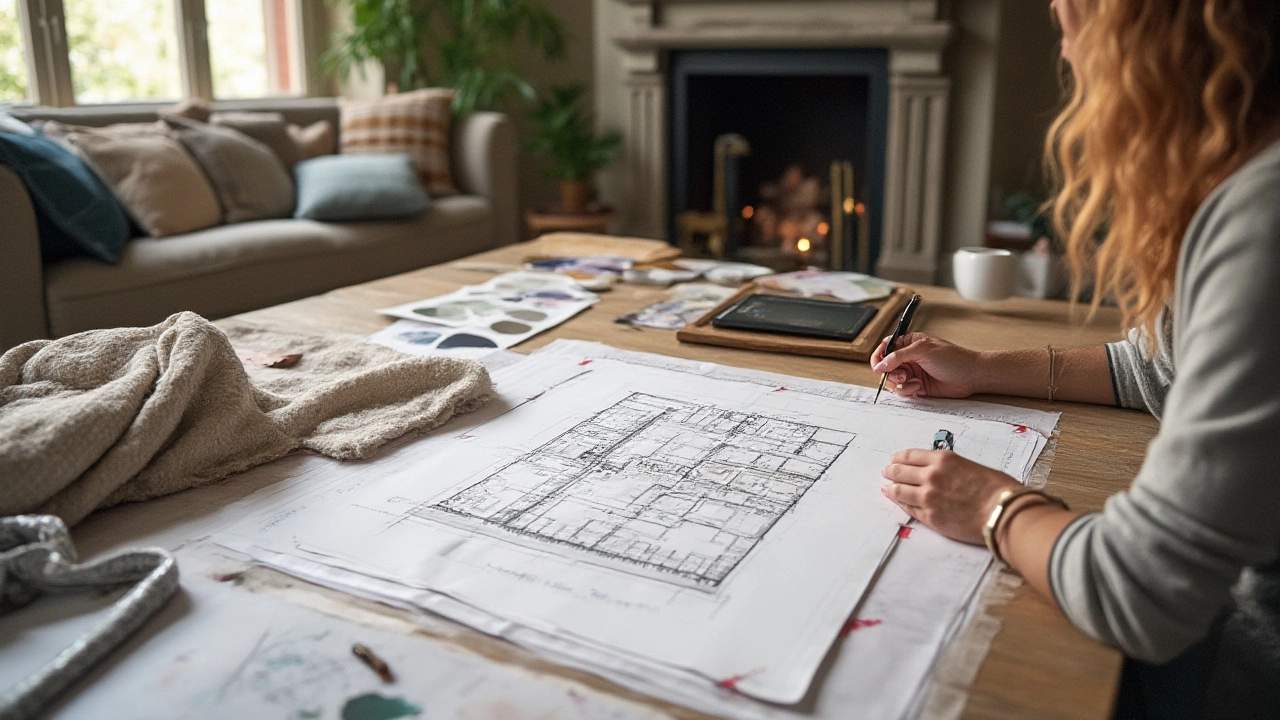If you’ve ever stood in a furniture showroom, eyed a gorgeous couch, and crossed your fingers hoping it’d fit in your living room, you already get it—math sneaks into interior design all the time. Forget chalkboard equations and scary numbers from high school; this is math putting on its toolbelt and getting stuff done. You might not need to solve quadratic formulas when picking out curtains, but you’d be shocked how much addition, subtraction, and just plain common sense arithmetic goes down before a room looks like a magazine spread instead of a shipping accident.
Where Math Pops Up in Every Interior Design Project
Let’s get real—nobody grabs trigonometry textbooks while picking paint colors. But math quietly steers a thousand tiny choices before a room comes together. When I revamped my own bedroom, I had to figure out if the headboard combined with the box spring would block the bottom half of my window...or miss it by an inch. That whole process is math disguised as measuring tape and a smartphone calculator.
For starters, it’s all about space planning. You’re not just putting stuff wherever there’s a blank wall. A typical living room remodel starts with measuring the dimensions—length, width, ceiling height, window size, where the door swings open, and how far grandma’s armchair sticks out. Standard sofa lengths? Usually 84 inches. Most coffee tables are about 18 inches tall. But how do you know what will fit? Grab a tape and add up the space each piece eats up, minus a comfortable two to three feet for walking paths (yep, that’s math again).
Then there’s furniture placement. Ever heard of the “Rule of Thirds”? It’s a classic design principle that leans on ratio and proportion. Accessories look better clustered in odd numbers—like a trio of vases rather than four—and artwork looks more striking hung at eye level, about 57 to 60 inches from the floor. Lighting? The bottom of a pendant lamp should generally hover 30 to 36 inches above your table. Even the cozy throw pillows on your couch owe their pleasing look to spacing and symmetry, both secretly rooted in numbers.
Math’s reach goes deeper if you’re laying down new flooring, swapping tile, or building shelves. Tile comes in boxes, but what you buy depends on calculating the square footage of your floor and maybe rounding up 10% to cover mistakes or the unexpected tile drop. A 12x16-foot room is 192 square feet. Most tiles come in square foot, so you’ll need at least 192 tiles, if they’re sold individually—plus that wiggle room. Do you want a rug under the dining table? Pick one that’s at least 24 inches wider than your table on all sides; otherwise, chairs get stuck or trip people up.
Found a wallpaper print that you love? Here comes some sneaky algebra: measuring the walls, subtracting window and door areas, figuring overlap, and translating roll size to coverage so you buy enough without splurging on too much. Swapping wall paint? Paint cans list coverage per gallon, so you need to multiply wall height by length for all four walls, and divide by the can coverage. Paint stores say, on average, a gallon covers 350 square feet, but oddly textured walls suck up more.
Lighting design stirs up the numbers, too. Most designers use a formula—multiply the room’s length by width (in feet), then multiply that by 1.5 to estimate total wattage needed for balanced brightness. For a 10-by-14-foot room, the math is 10x14=140, times 1.5 is 210 watts total. That could be four 60-watt bulbs, spread across ceiling lights and lamps.
Math isn’t just about what fits. It keeps you on budget. Say you have $5,000, and the couch chews up $2,100, while flooring is $1,200. Throw in window shades and ... running out of zeros fast? Budgeting is one big addition and subtraction problem. I once watched Maxwell try to sneak in a giant wall mirror. Math quickly pointed out that we needed to eat next month, so maybe the mirror could wait.
| Design Task | Math Skill Involved | Typical Measurement or Formula |
|---|---|---|
| Furniture Planning | Addition, subtraction | Room size minus furniture dimension |
| Lighting Layout | Multiplication | Room sq. ft. x 1.5 = needed wattage |
| Floor Covering | Area calculation | Length x width = sq. ft. coverage |
| Wall Paint | Addition, division | Total wall area ÷ paint can coverage |
| Wallpaper Installation | Multiplication, division | Wall area ÷ coverage per roll |
| Budget Tracking | Addition, subtraction | Costs of each item |
Sneaky, right? The *math in design* blends into everyday moves—you barely realize you’re doing it, but without it, nothing would fit, budgets get busted, and some poor soul trips on a too-small rug under the dining table.

Why Interior Designers Use Math—And You Should Too
If you picture interior designers as carefree artists, think again. Yes, they love colors, textures, and creating moods. But behind every dreamy space is someone crunching numbers. I follow a designer in Seattle who swears the most common client mistake is buying furniture that’s too big. She’s not just guessing—survey results show 42% of homeowners admit to buying pieces that don’t fit. All because they skipped the math and went by looks alone.
In the design world, math’s big role is precision. Let’s say you’re working on a tiny apartment. You want a table big enough for four, but it shouldn’t block the walkway. Designers mentally juggle numbers—20 inches per diner at a table, plus a couple extra feet so nobody bumps into walls standing up. That number dance gets even trickier in open floor plans, where kitchen, dining, and lounging zones all spill together. Here’s one quirky tip: To decide where to hang your pendant lights over kitchen islands, leave about 30 inches between the countertop and the bottom of the fixture, and 6 inches from the edge. These rules make for real comfort, not just pretty Instagram photos.
Curtains often cause grief, too. You want them to skim the floor, not puddle into a crumpled mess. Measure from the curtain rod to the floor, subtract the rod height, and you have the perfect panel size. Rods themselves should sit 4-6 inches above the window and extend 8-12 inches past each side to give that “grand” look—again, all sneaky math.
Let’s talk about color and light. Paint stores use the Light Reflectance Value (LRV) scale, which rates colors from 0 (pitch black) to 100 (blinding white). A room gets brighter or darker depending on color’s LRV; pick too low, and you’ll need tons of lamps. Even the famed 60-30-10 color rule—a balanced palette uses 60% dominant color, 30% secondary, 10% accent—relies on ratio. Mixing patterns? Designers keep to scale: a big, bold print needs to balance with smaller, subtler ones to keep eyes happy, not dizzy.
Then there’s custom work. Want floating shelves or built-ins? Designers whip out calculators, deciding how deep shelves can be without making the room cramped, keeping space between supports just right so sagging’s not a problem. More than half of my friends have shared tales of shelves that bowed under book weight, all because they ignored basic length and weight formulas.
Nothing about math here is rocket science. You don’t need to master calculus or memorize obscure theorems. You need basic arithmetic, an eye for symmetry, and willingness to double-check dimensions before pulling out a credit card. Technology helps, too; plenty of free apps calculate square footage or room layout. It’s not cheating—it’s being smart. Measuring twice before buying could save enough money to splurge on the statement lamp you’ve dreamed about...
Take wall art: Gallery walls look best when frames follow a grid, hung two inches apart horizontally and vertically. • Rug shopping? Measure your seating area, add at least 12-18 inches beyond the legs. A 5x8-foot rug under a queen bed is usually too small—the right one should extend at least 24 inches past both sides of the bed, so your toes land on softness (not cold floor) every morning.
Here’s a tip I told Maxwell when he wanted kitchen stools: Measure the counter’s height and subtract 10-12 inches. That’s the sweet spot for stool height—leg room for knees, without crouching. Skip the math and you’ll end up slouching or dangling like a kid on a barstool.
If you’re nervous about number crunching, remember this: Most design blunders happen when you skip the math. Math is there to help, not scare you. And, honestly, nothing beats the relief of knowing you bought the right amount of tile or your brand-new sofa glides through the front door—no angry returns, no regrets, and definitely no size-related tears.

Math Tricks, Time-Savers, and Pro Tips for Home Makeovers
Let’s get practical. You don’t need a math degree for a killer home makeover, just these cheat codes designers live by:
- Always measure everything twice. Not sure if that chandelier clears the door? Check your room’s height, the fixture’s length, and the chain or cord—it’s all about adding (or subtracting) inches.
- Breakrooms, kitchens, and tight spots: For comfy walking space, leave 36 inches minimum between counters and islands, or around big furniture. Your shins (and fridge doors) will thank you.
- When buying paint, always round up the square footage. Walls eat more paint than you think, especially if you have textured surfaces or bold colors.
- For gallery walls, cut paper templates of your frames and stick them to the wall with painter’s tape first. It lets you try different arrangements—no measuring math needed until you’re happy.
- Apps like MagicPlan or RoomScan (there’s tons more) turn room photos into floor plans, crunching numbers for you. Yes, technology’s your new BFF.
- Tile floors? Sketch a quick grid, noting any strange nooks or closets, and count tiles by area to avoid extra trips to the store.
- Don’t trust memory. Write down every measurement—door width, wall height, furniture sizes—before heading out to shop. Phones eat sticky notes; snap quick photos of your notes instead.
- Use formulas. Area equals length times width, always. But round up to the nearest foot for easier math—and to cover mistakes.
- Choosing curtains? Rod width = window width + 16 inches (8 inches each side), for fuller, hotel-style drapes.
- Put blue painters’ tape on the floor to map out furniture before you buy. Walk around, sit, open doors. Suddenly, all the math becomes something you can feel.
Got a shower renovation planned? Tiling floors, walls, and a ceiling uses at least three measurements per surface. Add 10% extra for odd cuts and slip-ups. Many hardware stores have in-store calculators if you get lost.
Let’s not forget budget tracking—you can use a free spreadsheet app or a notepad, as long as you jot down every cost as you go. Add, subtract, and see where your wallet stands, so you can—without guilt—pick up a little treat at the end (um, yes, that mirror is still on my wish list).
Math also helps in shopping online, where so many returns come from guessing the wrong size. Check retailers’ dimension guides, review customer photos, and grab a measuring tape before hitting “order.” Faster than waiting for refund processing—and you save yourself from the eternal return cycle.
So, does interior design require math? Yes—lots of it, quiet and steady in the background. But it’s the friendly sort. It keeps your home balanced, your budget safe, and your dreams right-sized. If you’re someone who swore off numbers years ago (hi, I see you), you might even find yourself kind of enjoying the way math makes a home just click. Trust me, it’s the secret decorating tool you didn’t know you already had in your back pocket.


